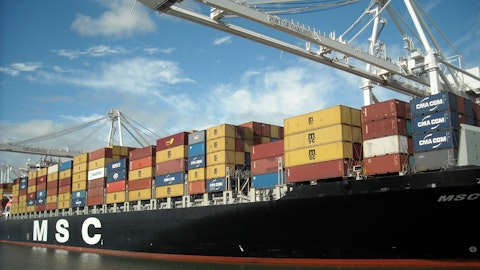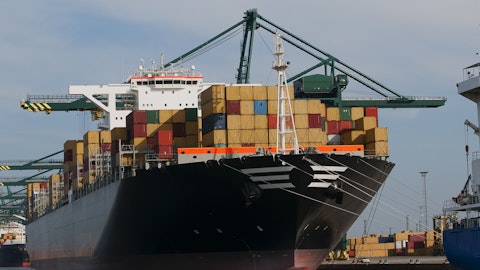And so if you look at the imports into the United States for the first 9 months of 2023, compare that to the first 9 months of 2019, and cargo volumes into the United States, both East Coast, West Coast, from all foreign origins is close to 7% higher than 2019. So while it’s true that there were significant declines in the year-over-year period and when and how we lap the bad news, just from a context standpoint, when we talk about seeing a new normal and are we there? We see the inventories have largely been absorbed these excess inventories to your first part of your question. And we see growth from that those levels. So it’s just another data point in our own thinking about us having reach an equilibrium and it’s also why we think that 2024 is going to look a lot like 2023, given those underlying factors.
So just again, at the risk of over answering your question, I wanted to provide some context into our thinking.
Jack Atkins : No, that’s really helpful. Maybe one more for me, and I’ll hand it back and jump back in queue, just to make sure everyone can jump in. But I guess we think about we’re trying to kind of frame up the “new normal” one area of the business that’s underperforming relative to pre-COVID, the SSAT joint venture. And obviously, it had some really good years there during the supply chain disruption but it’s losing a little bit of money now on a quarterly basis. How do you think about the normalized earnings power for that part of your business? And I guess what level of import activity do we need to see to be able to get back to a stable level of profitability there? I know you don’t own that asset outright. I’m just trying to kind of get a gauge for that.
Matt Cox : Yes. So first, I’ll say firstly that we’re going to have more to say about that in our year-end earnings call, but I can give you my thoughts at this point. So 2023 has — we don’t think not been a year yet of normalization in the joint venture. I think we’ll see a normalization occurring in 2024. And there were a couple of reasons for that. First of all, this inventory overhang that put — in the year ago period, a lot less cargo into the overall market has been impacted. But we also had a couple of other factors that we think were suppressing volumes during that period. One was the ILWU contract that was, as you know, extended. Finally now has been ratified and in place. And we think that cargo was diverted as our customers kind of derisked by bringing cargo either through the Suez all water route from Asia or in the Panama Canal.
But for 2024, I think there’s a couple of things that should happen. First of all, the inventory overhang will be largely behind us. There are some issues with the Panama Canal that with regard to the drought, which is causing on the margin of reduction of effective capacity for the U.S. Panama all water services from Asia. And then thirdly, there is a contract renewal for the ILA, which will occur in 2024 and some of the derisking that our customers did with the ILWU renewal in 2023, we think are likely to play and be a factor on the margin again, derisking. Those are, I think, factors that are going to allow a more normal level of performance in 2024 for the SSAT joint venture, but obviously not at levels, pandemic-area levels where there was significant cargo that was on the terminals and unable to be picked up by their customers because their warehouses were full.
So you would probably want to look back to an earlier year of SSAT profitability pre-pandemic and I don’t have those numbers in front of me. And again, we’ll have more to say about that in the next quarter’s call.
Operator: And our next question will come from Jacob Lacks of Wolfe Research.
Jacob Lacks : So your China volumes took another step up to around 39,000 containers this quarter. So it seems like you’re tracking well above the 120,000 to 130,000 annual run rate you gave a couple of quarters ago. Is this sustainable? Or how should we think about these moving forward?
Joel Wine : Yes, Jake, it’s Joel. It was a strong quarter for us, but we still think there will be seasonality. So the fourth quarter will have some light periods of time relative to the third quarter. So I would say don’t just take our 39,000 for the third quarter multiple-times something near 4 and assume that’s the annual rate. So we’re still sticking with the 120 to 130 total volume for the — 120,000 to 130,000 for the whole year. We’ll see how the fourth quarter plays out. And if we feel like adjusting that in 2024 basis, we can talk about that in February. But definitely caution that’s not going to be the run rate every quarter.
Jacob Lacks : Sounds good. And then it looks like share repurchases a little in the quarter. I guess, how should we think about the cadence there moving forward?


